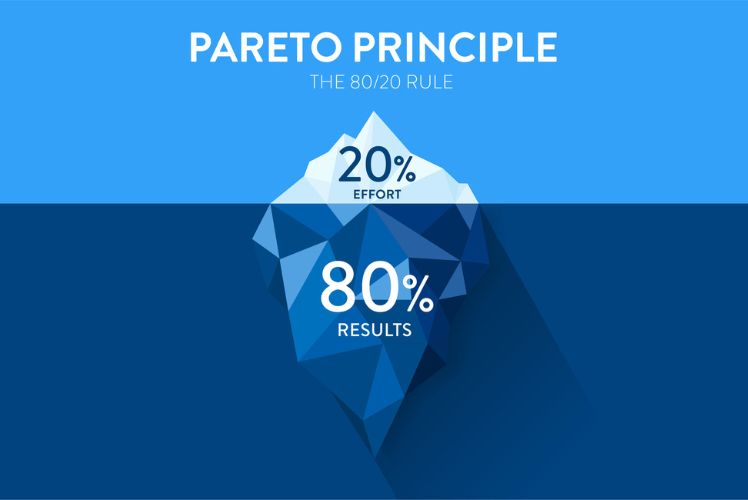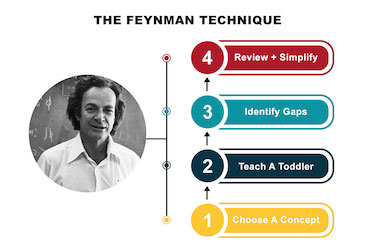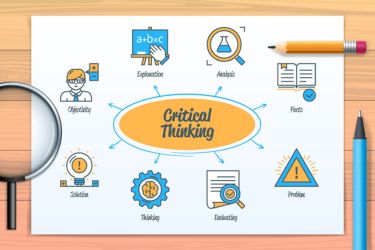The Pareto Principle, often referred to as the 80/20 rule, is a powerful tool for enhancing our learning experiences. By focusing on the 20% of our study material that yields 80% of the results, we can optimise our educational journey and make more effective use of our time. This principle encourages us to identify key concepts and information, enabling us to concentrate our efforts where they matter most.

Incorporating the Pareto Principle into our study routines can lead to better retention and understanding of the material. As we learn to prioritise essential content, we can develop smarter study habits and apply advanced techniques to maximise our learning outcomes. Ultimately, this approach empowers us to set clear goals and achieve them efficiently.
Key Takeaways
- Focus on key concepts for more effective learning.
- Develop study habits that prioritise important material.
- Set specific goals to enhance our educational journey.
Understanding the Pareto Principle

The Pareto Principle, often referred to as the 80/20 rule, is a key concept that helps us focus on what truly matters. By applying this principle, we can enhance productivity in various areas of our lives, including learning.
Origin of the 80/20 Rule
The term "Pareto Principle" comes from the work of Vilfredo Pareto, an Italian economist. He noticed that approximately 80% of land in Italy was owned by 20% of the population. This observation extended beyond economics. Pareto's findings have shown that in many situations, a minority of causes leads to the majority of results.
For example, a business may find that 20% of its clients generate 80% of its profits. By recognising this pattern, we can prioritise our efforts on the few factors that can lead to significant outcomes. This awareness empowers us to work smarter, not harder.
Application in Different Fields
The application of the Pareto Principle spans various fields. In education, focusing on 20% of key topics often leads to 80% of the learning outcomes. By identifying and mastering these core concepts, we can maximise our understanding.
In software development, companies like Microsoft have discovered that addressing 20% of common bugs can eliminate 80% of system crashes. This focus on prioritising key issues boosts productivity and efficiency.
In health and safety, the principle helps identify the most significant risks to manage, ensuring that efforts are concentrated where they can have the greatest impact. This targeted approach helps us use resources effectively and improve overall results in various aspects of life.
The Value of the Pareto Principle in Learning

By applying the Pareto Principle, we can significantly enhance our academic performance and focus on the activities that yield the best results. This approach helps us prioritise our time and efforts efficiently.
Enhancing Academic Performance
When we utilise the Pareto Principle, we identify which study methods and materials deliver the best outcomes. For instance, if we focus on mastering 20% of the key concepts that appear in 80% of our assessments, we increase our chances of success.
We can also analyse past exam papers to discover patterns in frequently asked questions. By doing this, we can allocate our study time to those important topics. Creating a study schedule that prioritises these areas helps us retain critical information effectively.
Moreover, active learning methods such as summarising and teaching others can be particularly beneficial. These techniques encourage us to engage with the material, reinforcing our understanding and promoting long-term retention.
Focusing on High-Impact Activities
Identifying high-impact activities is crucial to maximising our study efficiency. We can evaluate our tasks and determine which ones contribute most significantly to our learning objectives. For example, attending review sessions or forming study groups often leads to deeper insights and better understanding.
We should also focus on activities that promote critical thinking, such as problem-solving exercises or discussions. By dedicating time to these high-impact tasks, we avoid the trap of merely completing assignments for the sake of it.
Lastly, we should not forget to minimise distractions during study sessions. Eliminating irrelevant tasks allows us to concentrate on what truly matters, thus enhancing our overall academic experience.
Identifying Key Parts of Your Study Material

To maximise our study efficiency, we need to focus on distinguishing the most vital information from what is less important. This will help us direct our efforts towards the key topics that significantly impact our understanding and performance.
Separating Essential from Non-Essential Information
To effectively study, we must first identify what truly matters in our materials. Essential information usually includes core concepts, theories, and principles that are frequently tested.
We can use the following steps:
- Review Past Exams: Look at past questions to find commonly tested topics.
- Highlight Key Concepts: While reading, use a highlighter for main ideas to separate them from minor details.
- Discuss with Peers: Engaging in discussions can clarify what others consider important.
By focusing on these areas, we ensure that our study time is spent wisely on the most impactful content.
Strategies for Targeting Key Topics
Once we identify the essential information, we must develop strategies to focus our studies. Here are some effective techniques:
- Create a Study Plan: Outline our study sessions around key topics to ensure balanced coverage.
- Use Active Learning: Engage with the material through summarising, teaching others, or applying concepts in practice.
- Utilise Visual Aids: Diagrams and mind maps can help visualise connections between concepts.
By employing these strategies, we can build a sturdy foundation in our subjects and enhance our learning outcomes significantly.
Developing Effective Study Habits

Creating effective study habits is crucial for maximising our learning potential. By focusing on a productive routine, emphasising quality in our sessions, and minimising distractions, we can significantly boost our productivity.
Establishing a Productive Study Routine
To start, we need a consistent study routine. Setting aside specific times each day for study helps us build a habit and makes studying a priority. We should choose a quiet place, free from noise, and gather all necessary materials before we begin.
Using techniques like time blocking can also enhance our study sessions. For instance, we can break our study time into focused intervals of 25-30 minutes, followed by a short 5-minute break. This method, known as the Pomodoro Technique, keeps us motivated and prevents burnout.
Quality over Quantity in Study Sessions
When it comes to studying, focusing on quality is more important than how long we study. We should aim to grasp the key concepts and core ideas instead of trying to memorise every detail.
Identifying the 20% of topics that yield 80% of the results will help us concentrate our efforts effectively. We can do this by reviewing past exams and quizzes to see which topics frequently appear. This targeted approach makes our study time more productive and less overwhelming.
Minimising Distractions and Time Wasters
To improve our study efficiency, we must identify and minimise distractions. Simple changes, like turning off our phone notifications or using apps that block distracting websites, can help us stay focused. We should set clear boundaries to create a conducive study environment.
Additionally, keeping our study area organised can reduce time wasted searching for materials. Investing in organisational tools can streamline our process, making it easier for us to find what we need. This way, we can dedicate more time to learning and less to managing our workspace.
Implementing Advanced Study Techniques
To enhance our learning using the Pareto Principle, we can incorporate advanced study techniques like active recall and spaced repetition. These methods focus on reinforcing our memory and optimising the time we spend studying.
Leveraging Active Recall
Active recall is a powerful technique that requires us to retrieve information from memory rather than passively reviewing notes. We can create flashcards with questions on one side and answers on the other. When studying, we should focus on recalling the answer before flipping the card.
Another method is summarising what we've learned after reading a chapter or attending a lecture. This process helps solidify our understanding and identify areas needing more focus. Research shows that this retrieval practice can improve retention significantly.
Utilising Spaced Repetition
Spaced repetition involves reviewing material at increasing intervals. Rather than cramming, we should aim to revisit concepts after a few days, then weeks, and so on. This strategy helps us retain information longer.
To implement this, we can use apps designed for spaced repetition or create a study schedule. By organising our study sessions around this principle, we maximise our learning efficiency. Regularly reviewing what we’ve learned also reinforces our memory, making it easier to recall during exams.
Setting and Achieving Study Goals
To study effectively using the Pareto Principle, we need to set clear objectives and plan our study sessions strategically. This will help us focus on the most important material and use our time wisely.
Defining Clear Objectives
When we set study goals, clarity is crucial. We should define specific and measurable objectives. For example, instead of saying, “I want to study biology,” we can say, “I will complete chapter five and summarise key concepts by Friday.”
Using SMART criteria is helpful:
- Specific: What exactly do we want to achieve?
- Measurable: How will we track our progress?
- Achievable: Is the goal realistic?
- Relevant: Does it align with our larger learning goals?
- Time-bound: When will we complete it?
By following these guidelines, we ensure our goals are focused and attainable.
Strategic Planning for Study Sessions
Effective time management is key to maximising our study time. We should develop a strategic plan for each session. To do this, we can create a study timetable that includes dedicated blocks for our objectives.
Here's a simple approach:
- Identify High-Impact Topics: Focus on the 20% that will give us 80% of the results.
- Allocate Time Wisely: Assign more time to complex subjects while leaving simpler topics for quicker revisions.
- Break It Down: Divide our study sessions into smaller, manageable parts.
This structured plan helps us stay organised and accountable, leading to more productive study habits.
Adapting the Approach to Complex Topics
When dealing with complex subjects, it is essential to break the material into manageable parts. We need to focus on the most important concepts to enhance our learning efficiency. By refining our approach, we can navigate tricky topics without becoming overwhelmed.
Breaking Down Complex Subjects
To effectively learn complex subjects, we should start by identifying the core ideas that provide a foundation for understanding. We can create an outline with main topics and subtopics to help guide our study sessions.
Using bullet points can simplify each section:
- Focus on key concepts first.
- Group related ideas together.
- Use visuals like mind maps for better retention.
This method allows us to concentrate on what matters most. As we grasp these basics, we can delve deeper into the specifics, reinforcing our understanding along the way.
Dealing with Information Overload
Information overload can hinder our learning. To manage this, we need to filter the material we engage with.
We can set clear goals for each study session. For example:
- Limit our reading to essential chapters.
- Use summarised notes that capture the main ideas.
- Eliminate distractions that reduce focus.
By prioritising the most relevant information, we can sharpen our comprehension and retain what is crucial. This strategy makes the study process smoother and more productive.
Conclusion: Working Smarter, Not Harder
Adopting the Pareto Principle can transform our learning process. By focusing on the 20% of our study strategies that yield 80% of our results, we can achieve more with less effort.
We can begin by identifying the key concepts that are essential for our subjects. This helps us prioritise what to focus on during our study sessions.
Effective Strategies:
-
Pomodoro Technique: Using 25-minute study intervals allows us to concentrate fully and then take short breaks, which reduces stress.
-
Active Learning: Engaging with material through summarising, teaching others, or discussing concepts helps reinforce knowledge.
-
Adapt to Our Learning Style: Recognising if we are visual, auditory, or kinesthetic learners enables us to tailor our methods for better retention.
By implementing these strategies, we can allocate our time and energy more wisely. This not only improves our performance but also reduces feelings of overwhelm.
In our educational journey, let's remember to work smart. By concentrating on what truly matters, we set ourselves up for success while maintaining a healthy balance in our studies.
Frequently Asked Questions
In this section, we will address common questions about applying the Pareto Principle in learning. Each query focuses on practical methods, influences on teaching, and the impact on productivity in academic settings.
How can one implement the 80/20 rule for efficient study practices?
To apply the 80/20 rule in our studies, we should identify the key topics that yield the most significant results. This means focusing on essential concepts that frequently appear in assessments. We can analyse past exams and course materials to pinpoint these priorities and concentrate our efforts accordingly.
In what ways does the Pareto Principle influence teaching methodologies?
The Pareto Principle shapes teaching by encouraging educators to prioritise foundational concepts in their lessons. By focusing on 20% of the material that leads to 80% of student understanding, teachers can enhance learning. This approach helps to streamline lesson plans and allows for deeper exploration of critical topics.
What are some practical examples of the Pareto Principle in educational settings?
In educational settings, we can see the Pareto Principle in action through prioritised study guides. Many students focus on the most commonly tested subjects, which often results in better exam performance. Schools may also centre their curricula around key skills that align with student success in assessments.
How can the 80/20 rule be applied to enhance productivity in academic pursuits?
We can enhance our academic productivity by identifying the tasks that lead to the best results. This might mean dedicating more time to high-impact assignments or projects. By allocating our time wisely based on the 80/20 rule, we can achieve our academic goals more efficiently.
What strategies exist for applying the Pareto Principle to time management for students?
For effective time management, we can use the Pareto Principle to find tasks worth our focus. By recognising which assignments contribute most to our grades or learning, we can prioritise those. Creating a schedule that emphasises these tasks helps to ensure we make the most of our study time.
How can the 80/20 rule improve learning outcomes in business education?
The 80/20 rule is particularly useful in business education, where understanding core concepts can lead to practical applications. By focusing on the fundamental principles that drive business success, we can better grasp complex topics. This targeted approach can lead to improved outcomes in both comprehension and real-world application.





















